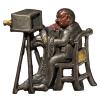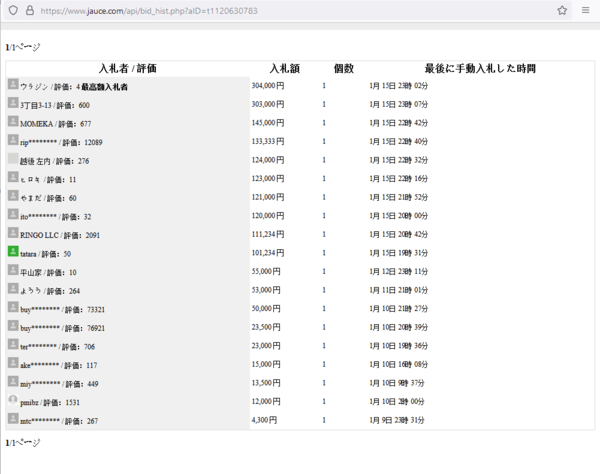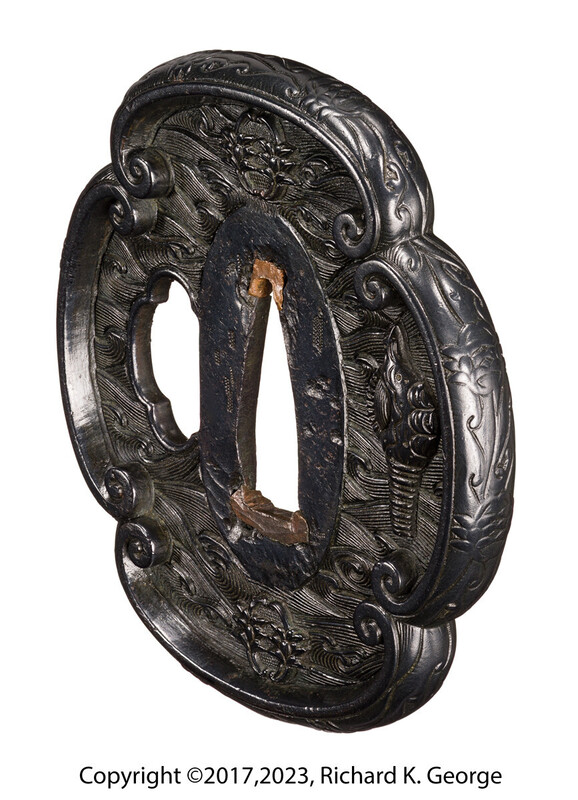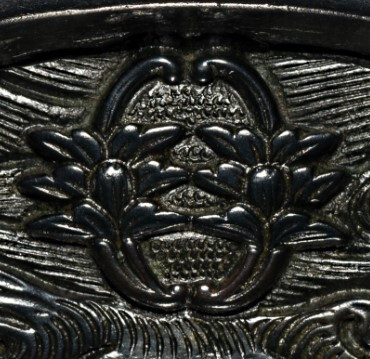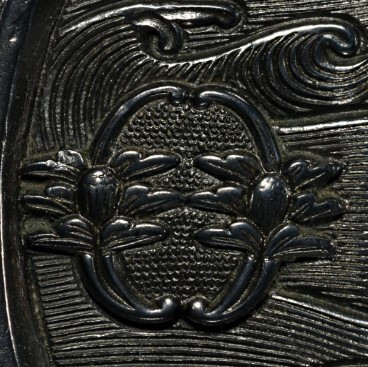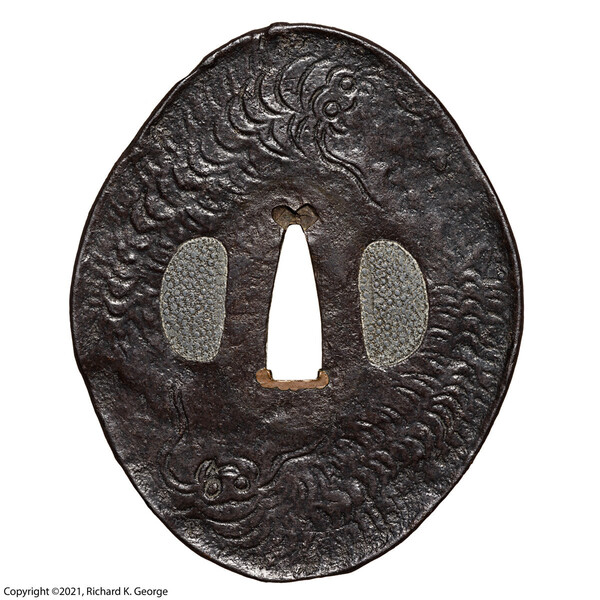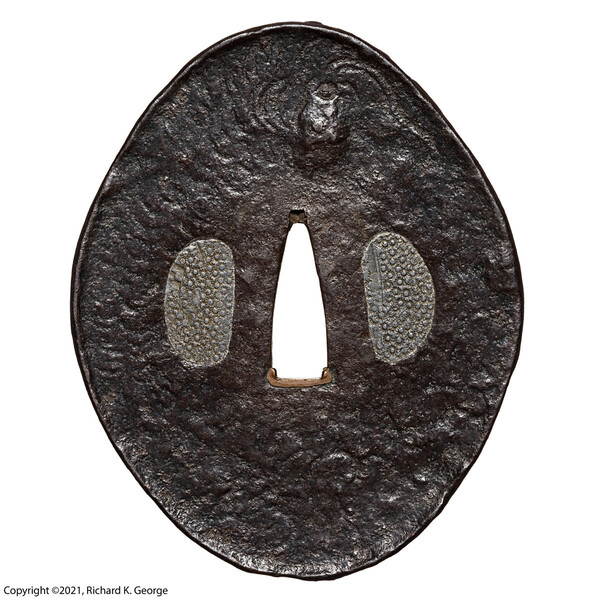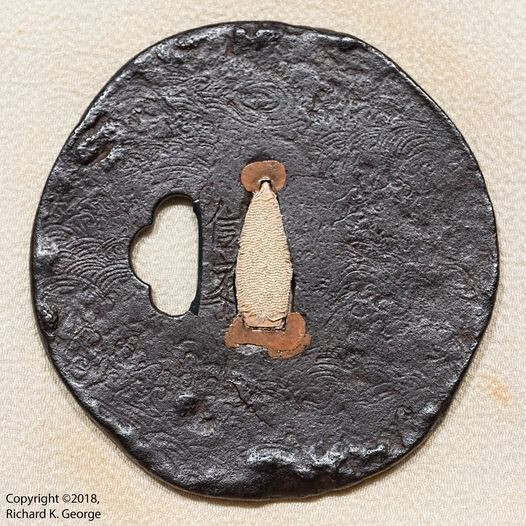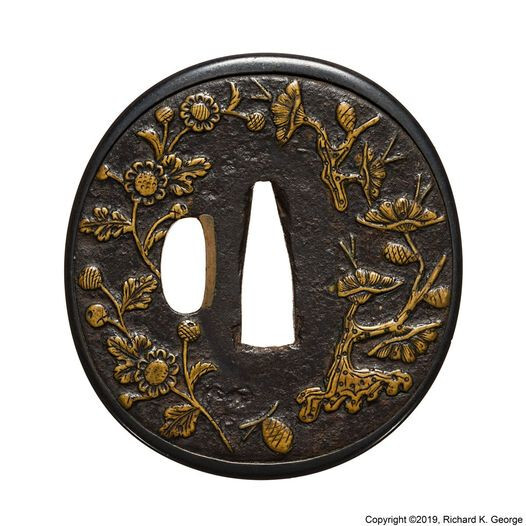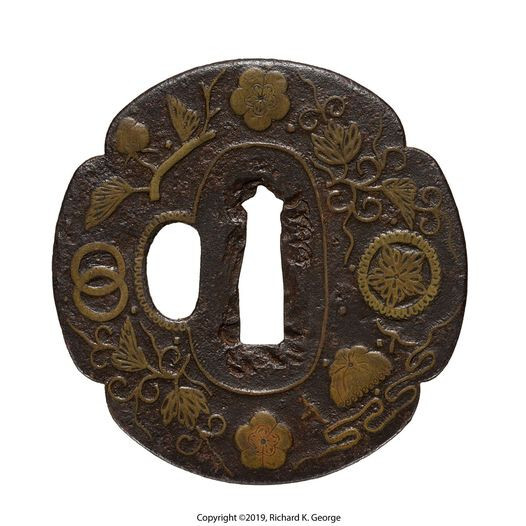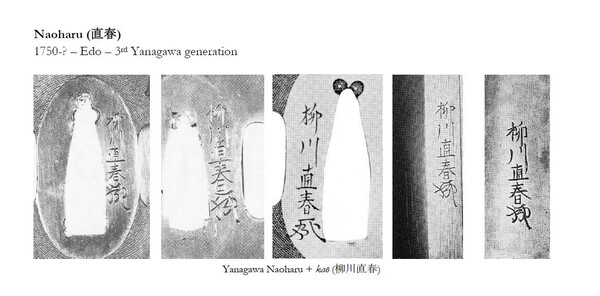-
Posts
815 -
Joined
-
Last visited
-
Days Won
8
Content Type
Profiles
Forums
Events
Store
Downloads
Gallery
Everything posted by rkg
-
That would be the arsenic leaching out of the lead Best, rkg (Richard George)
-
you might as well use copper or silver. As an aside, does anybody use copper pennies (if you're us based) for this, or do you scare up pure copper or yamagane? (not that I'm suggesting defacing US currency as that would be illegal, but...) Best, rkg (Richard George)
-
Another pervasive surface hack used on iron pieces like yours is the dreaded "brown wax". A lot of material coming out of Japan these days suffers from this and sometimes the wax is laid on like putty to hide a multitude of sins. you can use some high test isopropyl alcohol on a q-tip somewhere inconspicuous, and if it comes off brown... Clear wax over a good surface with no active rust is a personal choice (and it does make a lot of pieces look better), but the hackers often use the brown stuff to hide active rust issues, deep pitting, areas of corrosion (that look like sandpaper), cracks, even out botched repatination, etc. This is bad because the corrosion continues under the surface - wax is permeable and the rust can still get what it needs to continue reacting. The sad part is that sometimes they'll use the brown wax even when there's nothing to hide - just as part of their rework process - I guess they think it makes the piece look better And.. you often can't just clean it off because it opens a whole can of worms to try and conserve the result. Best, rkg (Richard George)
-
Darrel, Old school gray cards were more for setting tone than being neutral gray. Sometimes the greys weren't neutral - fortunately, a lot of the newer ones have a true gray so you can set the colors/exposure accurately - FWIW, here's a card that also incorporates a white surface (a lot of photo editing tools play better with a white card than a gray card)as well as a scale - I normally use a version of these that runs the scale down the side instead of just a short scale at the end: https://www.bhphotov...ration_Card_101.html They are real handy as you can leave them somewhere in the frame without it taking up too much room when shooting tosogu. Best, rkg (Richard George)
-
Lotsa gimei pieces showing up on YJ lately... rkg (Richard George)
-
Now that we are talking about cataloging... Here's an old thread that shows now I label tsuba boxes. I use a 3M product where they put post-it material on the back of photo paper. I choose it because its supposedly archival and also theoretically doesn't damage whatever is on the surface (it was developed to be able to put markers in old books after all) - not a big deal if the box is new, but if you want to provide info on a piece with a hakogaki by somebody famous, you probably don't want to damage anything (and on those I usually only put end labels in any case). The problem is that they lay on the adhesive in strips which means you have to be careful about label placement - it works best if there is adhesive at both ends so you have to place it to do that. because most of my items are stored stacked in a safe, In addition to a label on the top, I also put a label on the end so I can look for boxes w/o having to remove anything. This method also led me to start having decent tsuba box bags made that are open at one end. I saw a few box bags done this way on Yahoo!Japan and the light bulb went on... I would also add that another way to store them is like they did in the old days - they would just fold the piece in several pieces of washi and/ or mulberry paper (having a senior moment on the correct name) with a terse label on the outside saying what the piece is. This whole whizzy box thing really a pretty recent development, as I've seen these older "folded paper" storage dated as late as the taisho period. I have seen quite a number of "daimyo" kodogu that have been stored that way for a long time. Of course time marches on - now, most of the examples I've seen in hand have whizzy wood boxes with pull out sections to store all the extant old packaging. This is somewhat common on old Goto pieces that still have a goto kanteisho for example. I actually have done washi wrappers on a few pieces and put that whole assembly into a box - its lots easier to make an otoshi for rather than for the piece itself. The way the Japanese fold up things doesn't work with my brain well - I managed to get an example of one of these wrappers so I could use it as a model. Best, rkg (Richard George)
-
Another option is to just make a new liner - I know Ford had an article up on this, but weren't there a few others out there? I probably have something squirreled away, but.... Best, rkg (Richard George)
-
- 1 reply
-
- 1
-

-
I am late to the thread, as usual. Nice looking piece, Congratulations on the results! Best, rkg (Richard George)
-
Is the surface really that grey color? If so, that and the alternating coarse surface corrosion and the not really well defined seppa zuri makes me think it might have been burned at some point and the smooth surface might be scale. That does appear to be an early hitsu, though its hard to say if it is original to the piece or added later. From the thickness, I would guess its pre-edo, though kozuka came on the scene fairly late, so if original sometime at the end of the muromachi/ or momoyama might be a better date for the piece. On the other hand, older pieces often were flat on one side and "worked" on the other like you are describing, though typically the mimi is thinner than the seppa dai area on pieces that show that. But hey, they're all individuals at that point, so... Best, rkg (Richard George)
-
Does anybody have any idea what that tanto sized tsuba with the base attached that Dale posted might have been used for? I was trying to figure it out, and can't: https://www.jauce.com/auction/b1113231328 thx, rkg (Richard George)
-
- 7 replies
-
- 11
-

-

-

-
Peter, Fantasy design = mon I guess... The NBTHK most recently called the piece a tachishi, but its stranger than that - the tsuba is shaped like a 4 lobed mokko tachi tsuba (has that "waist" thing going on where the mune side of the tsuba is wider than the edge side), but has an ubu kozuka ana (and the decorations are meant to be viewed with the blade edge facing upward). Thanks to everybody who replied to this fruitful discussion. Best, rkg (Richard George)
-
Hi, I am trying to write up a description of a tsuba (no small task when you're hopped up on interesting chemicals) and I am having trouble trying to figure out what one of the decorations on the tsuba is. Does anybody recognize what mon/plant this is? A pal suggested it might be a tachibana plant, but I am unsure/seems like they normally show the fruit bigger. Thanks in advance for any help, rkg (Richard George)
-
Luca, No problem on the dimensions. I put up a description of the piece on Rich Turner's old kodogu no sekai FB page that I seem to have inherited. The papers are buried at the bottom of one of my safes under a large stack of tsuba boxes and it might take a while to get to them, so I'll have to get you some scans of those later. https://www.facebook...t=a.3953650578023594 And for those FB haters here's the description from the album: Mukade (百足) themed Myochin (明珍) tsuba I photographed this piece back in 2014 and was happy to purchase it when it recently became available. This otafuku gata (お多福形, oblong spindle shaped) tsuba is made from iron and measures 89.4mm (H) X 72.64mm (W) X 4.06mm (T,nakago ana), 5.33mm (T, max, mimi). It weighs 137.9g The tsuba has an uchikaeshi mimi (打返耳,upset edge) in which prominent tekkotsu (鉄骨, iron bones) are visible. The surface is very dark (which appears to be due to a combination of lacquer and finishing) and is decorated with mukade (百足, millipede (or ishimukade -石百足,stone centipede)). I think its pretty cool how they appear to “rise up” out of the piece (particularly on the back side). The age is hard to judge because the surface seems very well taken care of (and is waxed), but from the quality of work and large amount of arsenic that seems to have leached from the lead hitsu ana plugs, it appears to be fairly old, and I would date it to the early Edo period (17th Century). The piece has papers from several different groups, all attributing it to the Myouchin (明珍) group of tsuba makers. Best, rkg (Richard George)
-
Since the topic of Nobuie/Myouchin mukade themed tsuba has come up.... Here's one of those pieces that I had been trying to acquire for a really long time and finally got to a couple of years ago - its mumei and came with a stack of papers to Myouchin - I guess a former owner was trying for a Nobuie attribution or something... The back might actually be my favorite part because its pretty surreal (and yeah, I think there are two mukade there - the one on the bottom is pretty abstract) - the metal work reminds me a lot of a not-like-the-others Nobuie that I think is my favorite tsuba ever, but I digress. Aw, what the heck... I'll stick in an image of it anyway (the rocks/waves effect in hand is just brilliant) - apologies if this is too far off-topic: Best, rkg (Richard George) EDIT: no, I don't think mine is -really- a nobuie, its just really really cool to me...
-
Dale, That modification is not ideal, but it is what it is. The Japanese seemed to be pretty pragmatic about modifying kodogu to suit whatever their current need happened to be. Changing the shape like that is more extreme than say punching kozuka/kogai ana into pieces that didn't originally have them, but pieces with added hitsu are generally still considered to have value (though not as much as an equivalent piece that didn't have added hitsu). Sometimes buying modified pieces are the only way somebody on a budget can own an example w/o it being a complete wreck. I've had a couple of Ounin tsuba that were modified - one was reduced in diameter (which I won't post an image of out of deference to the new owner), and this one was made into a mokko shape: and here's an old heianjou where the owner modified the shape by adding an oval fukurin mimi in addition to the diameter probably having been reduced some (as well as having the more typical modification of an added kozuka hitsu): And I was just going to get back to work on editing a description of a Juyo kogai naoshi, so clearly the powers that be believe some modified pieces do have historic value... Best, rkg (Richard George)
-
Maybe the Sotheby's copy writer got a little overly enthusiastic But seriously, I wonder where the source of the story about shingen tsuba came from/was first recorded. As collectors we take so much of this as gospel w/o really knowing where the reference came from... Best, rkg (Richard George)
-
Dale, Lemonade from lemons time.... It might be worth keeping as a "don't buy one like this kids" warning or as a study piece - have you tried looking at the surface where the fractures occurred with a microscope yet? You could also have it analyzed or put it on the grinder and see what the sparks say about the material Best, rkg (Richard George)
-
Dale, Yup - that piece is mine - used with permission by Luca in his article. Best, rkg (Richard George)
-
Hi, I did a quick check on Haynes, and there was only one yanagawa guy that signed this way, so I think its this one: your mei pic is kind of blurry, but it doesn't look particularly close to the reference ones to me - but That observation is probably worth what you paid for it - you can compare it to the piece in hand and see what you think. There are several mid-late Edo kinko that seemed to attract Really Good forgers - an example of this would be (ichinomiya) Nagatsune. There are a tremendous number of pieces that his gimei on them, and a lot of those mei are really really close to "known good" ones. I have no idea if it was a financial/fraud thing or if it was one of those objects every important family "had" to have an example of, but... Best, rkg (Richard George)
-
Luca, I would think it would be binned as heianjou zougan, but... could it be binned Washida work instead? (I think i've only ever seen one washida group piece in person in hand so I'm not the best to comment on that). That said, its not a terrible piece - the inlayer put on a lot of inlay, it has a couple of different types of inlay metal, the amount of missing inlay appears to be below the 10% threshold that is considered acceptable, and... the surface is actually in pretty good shape, but yeah, the final price seems kind of er, enthusiastic compared to what other similar pieces have gone for on YJ in the past. But that has also been happening a lot lately on a surprising number of pieces coming through Yahoo!Japan of late for whatever reason - there's been a LOT of overly enthusiastic bidding on unpapered (when they "should" be), not in mint condition, etc machibori pieces for example. And the winners are usually gaijin so take that for whatever its worth... Overly enthusiastic bidding? Lack of top end material out there being made available to buy? some other reason? Best, rkg (Richard George)
-
I hate it when I run into these. Has anyone ever done a book or other compilation of kao by makers who were known sign (occasionally?) with just a kao? Best, rkg (Richard George)
-
This is a useful set, and there is an index or table of contents translation floating around. I think the pieces in Wakayama's kodogu 3 volume mei set (several of which have popped up lately on YJ, FWIW) is cross referenced to these too (or was it the other way around - too early in the morning (for me) to recall right now) Best, rkg (Richard George)
-
Brian, you could start by looking for comps on Yahoo!Japan maybe? There is a tremendous number of sales of fittings through that site, and would give you an idea of the "spot" price since the items actually sold (except when the seller decides he doesn't like the price, but that's a yahoo!Japan foible...) for example, I don't know how this set compares to the set above (the YJ one was actually pretty good/better than the ones shown perhaps), but here's a set that is along the lines of the one your pal has: https://www.sendico....hoo/item/q1096115829 https://page.auction.../auction/q1096115829 Just start putting similar things to what you want to value on your watch list and see where they end up. Good Luck - valuing stuff in thin markets is no joy. Best, rkg (Richard George)


